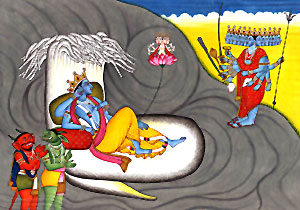In Hindu mythology, Kaitabha is fearsome demon, who along with his companion Madhu sprung from the ear of Lord Vishnu. Kaitabha and Madhu originated from the ear of Vishnu when he was sunk in his sleep of contemplation or Yoganidra at the end of the Kalpa.
 From the naval of Lord Vishnu, the lotus germinated. Lord Brahma, the creator, seated there and was planning to create the universe. Madhu and Kaitabh tried to disturb Brahma and intended to kill Brahma. Brahma came to known of their conspiracy and informed this to the goddess Mahamaya or Parvati. At this moment Vishnu was awakened and slain the two cunning demons Kaitabha and Madhu. This led to Vishnu being called Madhusudhana, the killer of Madhu and Kaitabha.
From the naval of Lord Vishnu, the lotus germinated. Lord Brahma, the creator, seated there and was planning to create the universe. Madhu and Kaitabh tried to disturb Brahma and intended to kill Brahma. Brahma came to known of their conspiracy and informed this to the goddess Mahamaya or Parvati. At this moment Vishnu was awakened and slain the two cunning demons Kaitabha and Madhu. This led to Vishnu being called Madhusudhana, the killer of Madhu and Kaitabha.
In another mythical legend it is said that when Brahma was planning to create the universe then the demons or asuras, Kaitabha and Madhu stole the Vedas from Brahma and threw them deep inside the waters of the primeval ocean. Lord Vishnu, in his another form as Hayagriva, killed them, and regained the Vedas. The bodies of Kaitabh and Madhu fall to twelve pieces, two heads, two torsos, four arms and four legs. The body parts represent twelve seismic plates of the Earth.




















